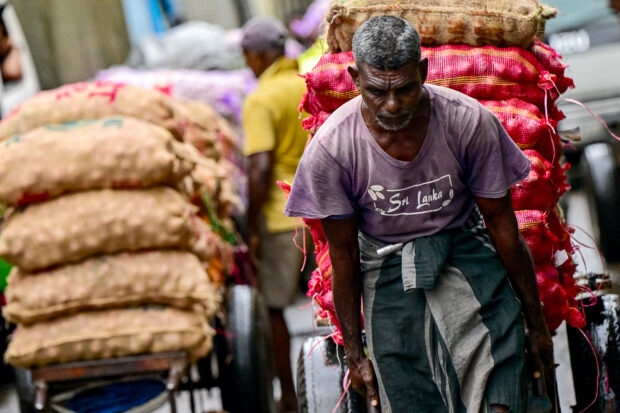Sri Lanka seals debt deal with China, others after crash

A laborer pulls a cart carrying sacks of vegetables at a wholesale market in Colombo on June 26, 2024. Cash-strapped Sri Lanka said on June 26, it had clinched a restructuring deal with a majority of bilateral lenders covering up to $5.8 billion in debt, a key step towards recovery after a 2022 financial crash. (Photo by Ishara S. KODIKARA / AFP)
COLOMBO — Sri Lanka said on Wednesday it had clinched a restructuring deal with key bilateral lender China and other nations, covering up to $10 billion in debt, a critical step towards recovery after a 2022 financial crash.
The agreement is expected to revive stalled infrastructure projects, including a Japanese-funded airport expansion and a new mass transit light rail in the capital, President Ranil Wickremesinghe said.
Sri Lanka defaulted on its foreign debt in April 2022 after running out of foreign exchange, and the unprecedented economic crisis forced then-president Gotabaya Rajapaksa to step down.
“Sri Lanka concluded negotiations with the Official Creditor Committee (OCC) and the Exim Bank of China,” Wickremesinghe said in a televised Sinhalese-language address to the nation.
“Sri Lanka won,” he added in English while thanking the OCC, which included Japan, India, the United States, Canada and several European nations.
He said the deal with OCC nations was reached in Paris, while an agreement with the Exim Bank of China was signed in Beijing on Wednesday.
Moratorium on repayments
Sri Lanka secured a moratorium on repayments until 2028, he said, but gave no further details.
His supporters in the capital Colombo let off firecrackers and distributed milk rice in celebration as he spoke.
Wickremesinghe said the nation was bankrupt when he took over almost two years ago and he hoped the International Monetary Fund bailout of $2.9 billion he secured last year would be the island’s last.
Colombo had gone to the IMF, the international lender of last resort, on 16 previous occasions and the debt restructuring is a condition of the IMF bailout.
Wickremesinghe has doubled taxes, removed generous energy subsidies, and is set to sell off loss-making state enterprises to shore up state revenue under that deal.
Neighboring India welcomed Sri Lanka’s deal and pledged more support.
“This milestone (agreement) demonstrates the strong progress made by Sri Lanka in stabilizing its economy and moving towards reform and growth,” the Indian government said in a statement.
Bilateral creditors account for 28.5 percent of Sri Lanka’s outstanding foreign debt of $37 billion, according to treasury data from the end of March.
China accounts for $4.66 billion of a total of $10.58 billion borrowed from other countries.
Japan accounts for $2.35 billion and India for $1.36 billion.
The government said it was in talks with international bondholders but there was no agreement. A previous round of talks ended in deadlock in April.
Unfreezing of loans
Sri Lanka is unable to raise commercial loans until a deal with private creditors is struck.
However, the agreement with bilateral creditors allows the unfreezing of loans for ongoing infrastructure projects financed with funding from other countries.
Thousands of teachers from government schools went on strike in Colombo on Wednesday demanding higher pay, with police using water cannon and tear gas to disperse the protest.
Sri Lanka is due to hold a presidential election this year and opposition parties have vowed to renegotiate the terms of the IMF bailout.
The IMF’s Sri Lanka mission chief Peter Breuer said the fund was willing to listen to alternative proposals from rival political parties, but said it was necessary to stick to the benchmarks set in the bailout.
Sri Lanka had made good progress but was not out of the woods yet, he said.